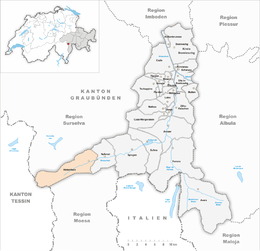Hinterrhein GR
| Hinterrhein | ||
|---|---|---|
 |
||
|
||
| Coordinates: 46°32′N 9°12′E / 46.533°N 9.200°ECoordinates: 46°32′N 9°12′E / 46.533°N 9.200°E | ||
| Country | Switzerland | |
| Canton | Graubünden | |
| District | Viamala | |
| Area | ||
| • Total | 48.3 km2 (18.6 sq mi) | |
| Elevation (Kirche Hinterrhein) | 1,620 m (5,310 ft) | |
| Population (Dec 2016) | ||
| • Total | 68 | |
| • Density | 1.4/km2 (3.6/sq mi) | |
| Postal code | 7438 | |
| SFOS number | 3691 | |
| Surrounded by | Blenio (TI), Malvaglia (TI), Mesocco, Nufenen, Vals | |
| Website |
www SFSO statistics |
|
Hinterrhein (Romansh: Valragn) is a village and a municipality in the Viamala Region in the Swiss canton of Graubünden. The village is located near the start of the river Hinterrhein/Rein Posteriur, one of the two initial tributaries of the Rhine.
Hinterrhein is first mentioned in 1219 as de Reno.
Hinterrhein has an area, as of 2006[update], of 48.4 km2 (18.7 sq mi). Of this area, 22.7% is used for agricultural purposes, while 7.6% is forested. Of the rest of the land, 1.2% is settled (buildings or roads) and the remainder (68.5%) is non-productive (rivers, glaciers or mountains).
Before 2017, the municipality was located in the Rheinwald sub-district, of the Hinterrhine district, after 2017 it was part of the Viamala Region. It is a haufendorf (an irregular, unplanned and quite closely packed village, built around a central square) located on the northern portal of the San Bernardino tunnel.
Hinterrhein has a population (as of 31 December 2016) of 68. As of 2008[update], 6.4% of the population was made up of foreign nationals. Over the last 10 years the population has stayed stable.
As of 2000[update], the gender distribution of the population was 57.7% male and 42.3% female. The age distribution, as of 2000[update], in Hinterrhein is; 9 people or 8.6% of the population are between 0 and 9 years old. 2 people or 1.9% are 10 to 14, and 6 people or 5.7% are 15 to 19. Of the adult population, 14 people or 13.3% of the population are between 20 and 29 years old. 19 people or 18.1% are 30 to 39, 19 people or 18.1% are 40 to 49, and 11 people or 10.5% are 50 to 59. The senior population distribution is 14 people or 13.3% of the population are between 60 and 69 years old, 9 people or 8.6% are 70 to 79, there are 2 people or 1.9% who are 80 to 89.
...
Wikipedia




